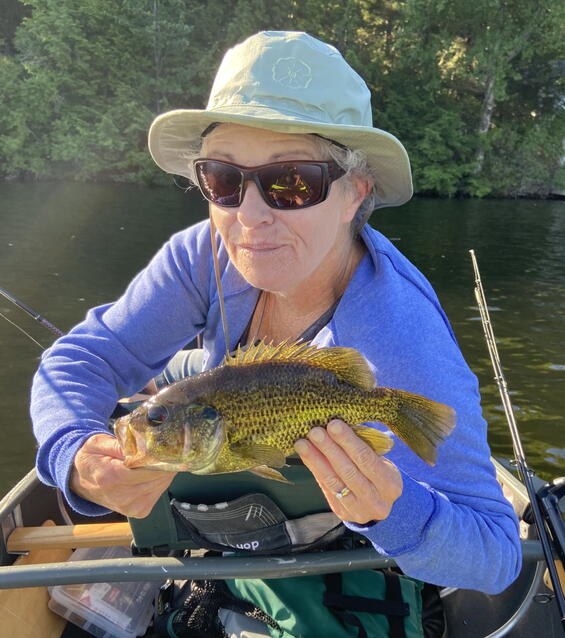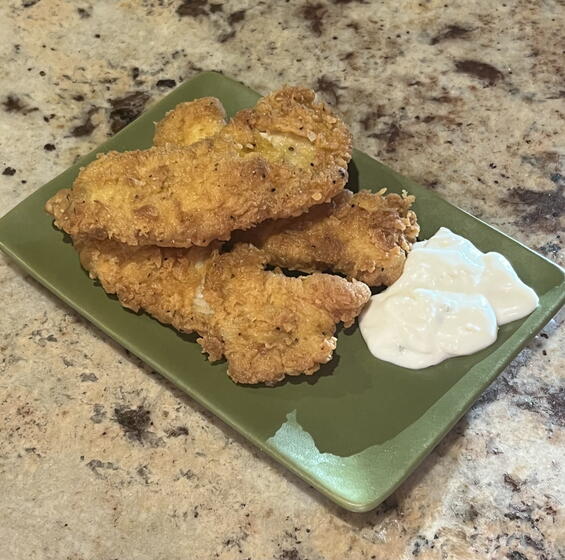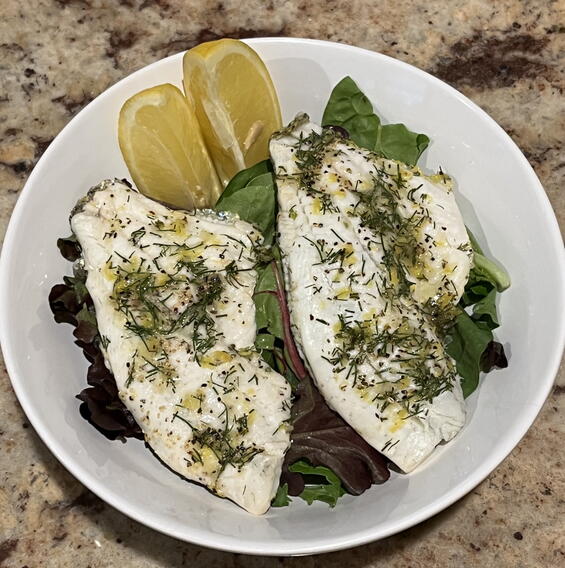Tips for catching

- Panfish will strike at a variety of natural and artificial baits. Try live baits like earthworms, crickets, or minnows.
- Small 1/16 or 1/32 oz. jigs tipped with artificial grubs or minnows can also be effective and allow you to target panfish at a greater depth.
- When fishing with live bait, stick to small hooks. Size 6 and 8 are best, but a size 4 may help keep some of the smaller fish off your hook.
- Target areas with overhanging vegetation, submerged trees, shaded docks, and aquatic vegetation, as panfish often seek cover.
- Light or ultralight action fishing rods paired with small reels loaded with 4 or 6 lb. test line provide a perfect amount of sensitivity and strength to handle these species.
- Don’t be afraid to search deeper areas where fish may congregate to escape the warm temperatures of the summer (this is often where larger panfish take refuge).
Tips for keeping fish
- In Massachusetts, there are no size or bag limits for crappie, bluegills, perches, or pumpkinseeds. Larger fish will be easier to fillet and will provide a larger meal. Click here to review freshwater fishing regulations.
- Bring a cooler with ice or use a stringer (improvised or store-bought).
- Pull a gill or two out with your fingers or slice through them with a knife to bleed the fish while it sits in the cooler or on the stringer. Bleeding the fish before filleting will provide a cleaner finished product without any flavor of blood in the meat.
- Be patient, filleting takes practice. Maintaining a sharp knife is essential for clean cuts.
Preparation and cooking tips
Fish are nutritious and provide a lean source of protein and omega-3 fatty acids. Learning how to prepare and cook a fish you caught yourself can be extremely rewarding. Panfish fillets are smaller than store-bought options, which can make culinary options easier to prepare.
Familiarize yourself with the latest fish consumption guidelines before eating freshwater fish. Advisories exist for certain freshwater bodies and for certain groups of people, including pregnant women, women who may become pregnant, nursing mothers, and children under 12 years old. Get more information about safe fish consumption from the Department of Public Health.
How to fillet
While you may choose to cook your fish whole, filleting does have some benefits. Removing the bones may make the fish easier for some people to eat. By filleting, you are also removing skin, organs, and body fats associated with contaminants like PCBs.
Always keep a sharp knife and protect your hands from cuts by wearing fillet gloves.
Video: fillet sunfish video
Skip this video fillet sunfish video.How to fry
- Use an oil that is has a high smoke point. Canola, vegetable, and peanut oils are good options.
- Use a high-walled pot or pan to help keep oil in the pan and minimize the mess.
- When you pull your fish from the oil, let it rest on a plate with some folded paper towels to absorb excess oil.
- Try to minimize the number of times you flip the fish while pan frying.
How to grill
- Using aluminum foil as a pan on the grill will help prevent the fillet from crumbling and falling through the grill grate. It also aids in clean up.
- Reapply seasoning or marinade 2–3 times while grilling to help bind more flavor to the meat.
- Since panfish fillets are thin, tend the grill often and pull the fish right as the meat easily flakes with a fork, to avoid overcooking.
- Any traditional fish seasoning, like Old Bay and lemon pepper, will pair well with panfish.
Panfish recipes
Easiest pan-fried panfish
Ingredients

- 1 cup all-purpose flour
- 2 cups canola oil (or other frying oil)
- ½ cup of yellow mustard
- ½ tsp. salt
- 1 tsp. black pepper
- ½ tsp. garlic powder
- 2-gallon sized Ziplock bags
- 1 lb. boneless, skinless, rinsed panfish fillets
Steps
- Add oil to a medium-sized pan (whatever style you prefer; cast iron works great). Heat oil to 375°F. If you don’t have a thermometer, drop a small dash of flour in the oil and if it begins to bubble you can assume its reasonably hot and ready for frying.
- In one Ziplock bag, add the mustard. In the other Ziplock bag add flour, salt, black pepper, and garlic powder. Shake the bag with the flour to thoroughly combine.
- Place all fillets in the Ziplock bag loaded with mustard. Shake and squeeze the bag to thoroughly coat all sides of each fillet.
- Remove mustard-coated fillets from the first bag and load them all into the second Ziplock bag with the seasoned flour. Shake the bag to thoroughly coat each fillet with the flour mixture.
- In small batches, load coated fillets into the hot oil. When they start to firm up, it’s time to flip them over.
- It should take about 6–8 minutes (3–4 minutes per side) for fillets to cook. Remove when fillets are golden-brown and feel firm.
- Enjoy with any sides you would regularly serve with fried fish.
Black pepper lemon dill panfish
Ingredients

- 2 tsp. lemon zest
- ½ tsp. salt
- 1 tsp. black pepper
- Juice of 1 lemon
- Fresh dill, chopped (to taste)
- 1 tbsp. olive oil
- 4 skin-on panfish fillets (crappie or perch)
Note: This method works best if you take the time to remove the scales on the skin, but this is optional. Instructions below describe steps with skin on.
Steps
- Rinse fillets in cold water and pat dry.
- Fold a sheet of aluminum foil onto the grate of your grill and spray with a thin layer of oil.
- Preheat the grill to around 375°F.
- In a small bowl, combine the lemon zest, salt, black pepper, chopped dill, olive oil, and lemon juice. Whisk well.
- Place the fillets, skin side down, onto the foil on the grill.
- Spoon seasoning liquid over each fillet until coated. You should have enough extra marinade to apply a second coat after about 5 minutes.
- When the fish begins to flake with a fork, generally after cooking for 10–12 minutes, remove the fish from the grill and enjoy.
Before hitting the water, don’t forget to get your freshwater fishing license. Have a favorite fish or game recipe to share? Connect with us on Facebook or Instagram.